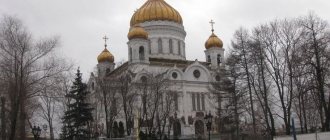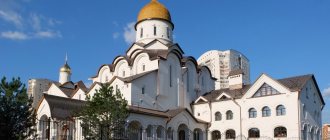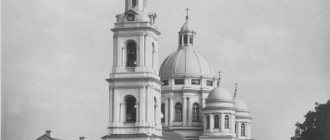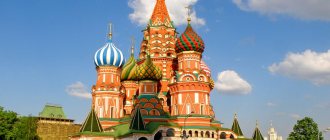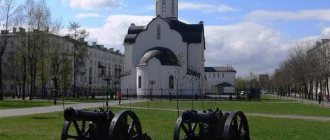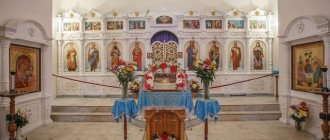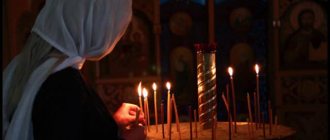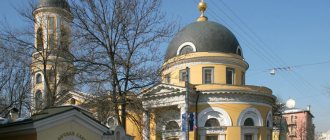Website: https://hramnevskogo.ru Email, Address: St.
Lobachevsky, 23 Telephone Schedule of services: https://hramnevskogo.ru/raspisanie-bogosluzheniy.html Directions:
From the Prospekt Vernadskogo metro station by buses No. 793, 788 From the Yugo-Zapadnaya metro station by buses No. 688, 785 From the Kuntsevskaya metro station by buses No. 688 and 688k
History of appearance
Against the backdrop of most of the sights that Yalta carefully preserves, the Cathedral of St. Alexander Nevsky stands apart. The fact is that it is the main Orthodox shrine of the city. As in everyone
populated areas of Russia, in the last quarter of the 19th century, they decided to erect some significant structure here in memory of the tragically deceased Tsar Alexander II (the Liberator).
The ensemble, which includes a tent-roofed building, is made in the style of Ancient Rus'. Hipped porches, gilded domes - everything points to the Moscow-Yaroslavl architectural school of the 17th century, nurturing the ancient traditions of Russian architecture. A follower of this trend, architect P. Terebenev, completed the project, according to which the construction work was carried out.
The main part of them was completed in 1902. The interior space of the main temple building in the resort city is Byzantine, that is, all the walls were painted thanks to the then famous Russian artists. The interior decoration was supervised by the no less popular architect Krasnov. The complex was consecrated in December of the same year, after which divine services began literally immediately.
History of the building
The Russian Prince of Novgorod Alexander saw his purpose in preserving Russian culture and spreading the Orthodox faith in Rus'. The prince became famous for protecting the Russian people from German knights on Lake Peipus and for the battle with the Swedes on the Neva, for which he received the name Nevsky.
During the burial of the prince, a miracle happened when they wanted to give him a letter, they tried to unclench his hands, but he himself unclenched his fist and took the scroll. Alexander Nevsky was canonized and elevated to the number of saints in the mid-16th century. Saint's Day December 6th.
The purpose of constructing the new Alexander Nevsky Cathedral at MGIMO had historical roots:
- Alexander Nevsky is the most famous hero of Russian history and the patron of warriors and diplomats. His unconventionality in building relations with Europe and Asia is still of interest today.
- At the construction site there used to be a wooden church of St. Nicholas, and a stone church appeared at the beginning of the 20th century. However, the events of the 1917 revolution led the temple to destruction and oblivion. Later, during the Olympics-80, the remains of the church were finally demolished and a park was laid out. The construction of the cathedral was a triumph of historical justice.
The best article for you, go to: Temple of Paraskeva Friday in Butovo, schedule of services
Cathedral of St. Alexander Nevsky in legends
At the end of the dark tenths of the last century, Yalta was also a mournful place. The Cathedral of St. Alexander Nevsky became the “spiritual bitterness” of the writer Fyodor Dostoevsky. In June 1918, a funeral service was held for his wife, Anna Grigorievna, in the local church.
Her last home was one of the Alupka cemeteries.
Only after decades had passed, the ashes of the “muse” of the great Russian writer were transferred to the Alexander Nevsky Lavra (in St. Petersburg), where Fyodor Mikhailovich himself now rests. They say that until his death he dreamed of the cathedral described in the article and occupying an important place in the list of “attractions of Yalta.”
Temple of the Holy Blessed Prince Alexander Nevsky
Etc. Marshala Zhukova, 43/2
The temple is located in the Krasnoselsky district and belongs to the Krasnoselsky deanery district. It was built quite recently, in 2010-2012. The architectural structure is designed in the form of a regular octagon made of brick, completed with a rotunda dome. The design of the church was carried out by the architect Boris Bogdanovich. Metropolitan Barsanuphius of St. Petersburg and Ladoga consecrated the temple on December 9, 2021.
The rector is Archpriest Daniil Melnikov.
Photo: peterburg2.ru
What is interesting about the church?
The Cathedral of St. Alexander Nevsky in Yalta is difficult to forget. The abundance of decorative elements amazes the eye - there are pilasters, and portals with elaborate carvings, and small icon cases, and “hearts”. The snow-white and golden miracle was built on two levels. Its galleries are open, and the porch is “covered” with a fabulous tent. In some places, white and pink tones captivate the eye, which makes the building even more festive, which is why the townspeople love to go to services here.
The icons are especially pleasing to lovers of shrines. They were made by bogomaz from Mstera (a village in the modern Vladimir region). Eleven bells for the bell tower (three-tiered) were cast in the capital. The largest of them weighs 428 pounds. The bells were donated to the temple by philanthropist N. Stakheev. The most interesting thing that is contained in the main part of the complex is a mosaic depicting Alexander Nevsky,
the result of the painstaking, months-long work of several creators under the leadership of the Italian Salviati.
The gilded carved iconostasis, which was made by Kyiv craftsmen at the end of the century before last, is also striking. All this can be photographed, but preferably not during the service. In the courtyard there is a church house built according to the drawings of M. Kotenkov. It is an ancient Russian tower. Its interior is also unreal. One gets the impression that visitors here are immersed in fairy-tale worlds created by Alexander Pushkin.
So, the Church of St. Alexander Nevsky in Yalta awaits guests until late in the evening. On Sundays and holidays, a liturgy is held here at 9 a.m. (on weekdays it starts at 8:00 a.m.). The all-night vigil gathers believers at five o'clock in the evening. On the territory of the cathedral building there are numerous shops for church supplies and paraphernalia.
Social activities
Church of St. blgv. book Alexandra Nevsky takes care of the city clinical hospital No. 31, which is a multi-building, multi-disciplinary medical complex equipped with the most modern medical equipment, operating since 1970 and designed to provide medical services to up to 40 thousand patients a year. The hospital employs about 900 people, some of whom regularly visit the chapel of St. Luke, Archbishop of Simferopol, located on its territory since 2013. For us, this is a great honor and opportunity to spiritually help those who selflessly work in the field of serving their neighbors.
In the Church of the Holy Blessed Prince Alexander Nevsky there is a 24-hour collection point for things in need : large and low-income families, other socially vulnerable segments of the population, as well as social assistance centers and shelters in the Tula, Nizhny Novgorod, Tver regions.
How to get to the temple?
Don't know how to get to the Cathedral of St. Alexander Nevsky? In Yalta, almost all public transport routes pass through the Morskaya Street stop. Those who want to visit the Orthodox complex should go here. The second way is to ride down the cable car from the hill with the Eternal Flame to the lower station. The clock tower is a landmark by which the street is located. Sadovaya.
You can drive or walk to the temple from the center of Yalta like this:
Note to tourists
- Address: Sadovaya street, 2, Yalta, Crimea, Russia.
- Coordinates: 44°29′44″N (44.495454), 34°9′50″E (34.163789).
- Telephone.
The Church of St. Alexander Nevsky in Yalta gives vacationers a real thrill of soul. In the 80s In the 19th century, majestic churches were erected in all corners of Russia in honor of the martyr-tsar killed by a terrorist bomb. Religious buildings were then dedicated to Alexander Nevsky, because he provided constant patronage to all Russian tsars. The Orthodox shrine is increasingly becoming the subject of memorable photos of Yalta guests! We offer an interesting video about it. Enjoy watching!
Liked? Share with your friends!
Monument to the founder of the Great Siberian Road
The Alexander Nevsky Cathedral is a cultural and religious building on the Trans-Siberian Railway, the heart and soul for the Orthodox citizens of Novosibirsk.
I treasure the memories of my first visit to the temple. Then he really struck me with his royal majesty. If this is your first time in our city, be sure to include this iconic place in your exploration route.
The cathedral was erected in honor of Alexander III, and is believed to have become a monument to the founder of the Great Siberian Road. The external design is dominated by the pseudo-Byzantine (or neo-Byzantine) style, which became popular in Russia in the second half of the 19th century. What I like most is that, architecturally, the cathedral is similar to the church assembly of St. Petersburg “In the Name of the Jubilant Mother of God.”
Funds for the construction of the cathedral were allocated by the heir to the throne of Alexander III, namely Nicholas II. The Tsarevich was traveling in the East when he received a telegram from Alexander III with an order to urgently leave for Vladivostok. It was this city that was chosen as the starting point of the Great Siberian Railway. Being a believer, Nicholas II proposed laying the foundation of a church on the construction site.
Temple of the Holy Blessed Grand Duke Alexander Nevsky
Leningrad region, Vyborg district, Sosnovy Bor sanatorium
In 1883, by order of Alexander III, the architect Labourde built a wooden temple. In 1905 it burned down. After the fire, by order of Nicholas II and under the patronage of the Dowager Empress Maria Feodorovna, architects Julius Bruni and Carl Gustav Ludwig Shulman built a church of stone.
After the revolution, the temple ended up on the territory of Finland, and from 1925 to 1939 it was used as a Lutheran church. And when, after the Great Patriotic War, the territory became part of the USSR, a cinema and a grocery store were built here, and in the lower part of the altar there was a stoker.
In 1992, the temple was returned to the Russian Orthodox Church, and regular services began there. In 2021, by order of His Holiness Patriarch Kirill of Moscow and All Rus', the temple was transferred to the Vyborg diocese.
Photo: globus.aquaviva.ru
Architectural style
The cathedral was built in the Old Russian style and looks like a tower, decorated with lace architecture. A large number of carved hearts, pilasters and portals only adds to its originality. The building was built in two tiers, with open galleries and tent rings. The white and pink colors in which the temple is painted add festiveness and solemnity to the structure. Skilled and gifted craftsmen in the Vladimir province became the place where they made icons for the temple. Patron Stakheev donated 11 bells, which were cast and brought from Moscow itself.
The interior design had to match the exterior. It was made in the Byzantine style: the dome was painted, and the image of Alexander Nevsky was laid out in a mosaic frame.
Story
Construction was lengthy and took about fourteen years. Difficulties arose in coordinating projects and sponsoring work. At one time or another, the work was supervised by Robert Yakovlevich Kilevein, who also participated in the construction of the Nativity Church, and the architect Lev Vladimirovich Dal, the son of the author of the explanatory dictionary.
© Artem Kuznetsov
The new cathedral was illuminated in July 1881. Another emperor, Alexander III, was already present at the ceremony.
During the Soviet years, the cathedral came under repression, like many others at that time. It was closed and the property was confiscated. The main pride - the twenty-meter iconostasis was used for firewood to heat nearby houses. Through the efforts of believers, it was possible to preserve the miraculous icon of the Mother of God and the life-giving Cross of the Lord.
© Dmitry Orishchenko
In the future, it was planned to demolish the cathedral and build a lighthouse with a monument to Vladimir Lenin in its place. The plan was not realized. For a long time the building was used as a warehouse. During the war, there was a fire inside, destroying the frescoes on the walls. There was an anti-aircraft battery on the roof, protecting the city from enemy raids.
The restoration of the cathedral after everything that happened began only in 1983. Eight years later it was transferred back to the church for management. Later it received cathedral status.
